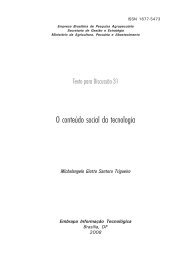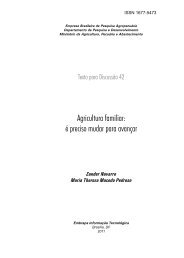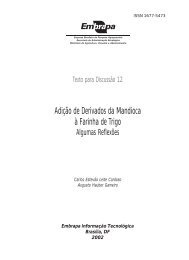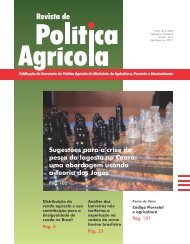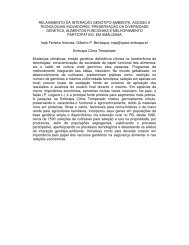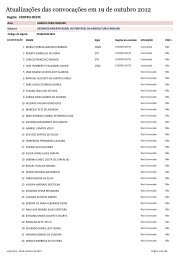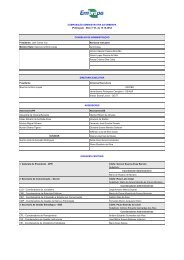Ministry of Agriculture, Livestock and Food Supply - Embrapa
Ministry of Agriculture, Livestock and Food Supply - Embrapa
Ministry of Agriculture, Livestock and Food Supply - Embrapa
You also want an ePaper? Increase the reach of your titles
YUMPU automatically turns print PDFs into web optimized ePapers that Google loves.
Table 12. Energy produced exclusively from wood in 1999.<br />
Region<br />
Africa<br />
Asia<br />
Europe<br />
Middle East<br />
North America<br />
Oceania<br />
South America<br />
World (1)<br />
(1) Does not include black liquor.<br />
Source: IEA Statistics.<br />
Mtep<br />
141.1<br />
38.5<br />
37.7<br />
216.1<br />
34.9<br />
0.2<br />
3.8<br />
472.3<br />
91<br />
%<br />
29.9<br />
8.1<br />
8.0<br />
45.8<br />
7.4<br />
0.0<br />
0.8<br />
100.0<br />
The largest biomass energy consumer is the rural sector. The rural per<br />
capital consumption is estimated at 1 t/year (15GJ), while consumption falls by<br />
50% in urban areas.<br />
The variations in energy consumption from plain firewood <strong>and</strong> its<br />
residues are strongly associated with the degree <strong>of</strong> development <strong>of</strong> the country.<br />
Firewood is commonly used in the rural areas <strong>of</strong> developing countries <strong>and</strong><br />
accounts for almost all the energy used in the homes. Practically all<br />
consumption usually takes place where the firewood is produced.<br />
Charcoal consumption, on the other h<strong>and</strong>, is more common in urban<br />
<strong>and</strong> peri-urban areas. Close to 6 m3 <strong>of</strong> wood are required for the production <strong>of</strong><br />
one ton <strong>of</strong> charcoal. Thus, the price <strong>of</strong> charcoal includes the costs <strong>of</strong> the raw<br />
material, transportation, processing, <strong>and</strong> stocking.<br />
The production <strong>of</strong> energy from wood has fallen consistently in Brazil in<br />
the last few years. It is estimated that wood extraction decreased by 35% in<br />
the 1990s: from 106-million tons to 69.5-million tons/year. The main reason<br />
for the reduction was diminishing charcoal consumption in the homes (47%),<br />
industry (39%), agriculture (13%), <strong>and</strong> commerce (1%).<br />
In 1999, while 25-million tons <strong>of</strong> wood were transformed into charcoal,<br />
only .5-million tons <strong>of</strong> wood were used to generate electric power. In Brazil<br />
the main industrial consumers are the food <strong>and</strong> drink sector <strong>and</strong> ceramics<br />
<strong>and</strong> paper manufacturers.<br />
Eucalyptus plantations for charcoal production are estimated at 3-million<br />
hectares. If the forest biomass market improves, there will be a wood deficit in<br />
the next ten years due to the long maturity period required by reforestation projects.



